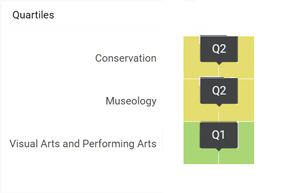Dismembered bodies and forensic sanctities: norms and practices surrounding contemporary catholic relics
Abstract
Since 1987, more than two thousand martyrs of what has been called the Religious Persecution of the Spanish Civil War have been beatified in Spain. Their bodies, which were killed and buried in mass graves, were later exhumed, reburied (often multiple times), and fragmented into numerous relics that multiply their power as mediators between heaven and earth in a process that began in the 1940s and has not yet concluded. This article reflects on the contemporary creation of these relics by analyzing the norms, uses, and practices of this peculiar form of Catholic worship, that treats sacred human remains with its own rules, endorsed by Ecclesiastical Law, outside the conventions on the conservation of other archaeological remains.
Downloads
References
CENTRO DE ESTUDIOS BORJANOS (2015). Las reliquias de San Francisco de Borja y otro libro. http://cesbor.blogspot.com/2015/01/las-reliquias-de-san-francisco-de-borja.html [13/19/2023]
CONGREGACIÓN DE LAS CAUSAS DE LOS SANTOS (2017). Instrucción. Las Reliquias en la Iglesia: Autenticidad y Conservación. http://www.vatican.va/roman_curia/congregations/csaints/documents/rc_con_csaints_doc_20171208_istruzione-reliquie_sp.html [10/09/2023]
CONGREGACIÓN DE LAS CAUSAS DE LOS SANTOS (2020). La causa de los santos. Manual Salamanca: BAC.
CONGREGACIÓN PARA EL CULTO DIVINO Y LA DISCIPLINA DE LOS SACRAMENTOS (2002). Directorio sobre la piedad popular y la liturgia. Principios y orientaciones. http://www.vatican.va/roman_curia/congregations/ccdds/documents/rc_con_ccdds_doc_20020513_vers-direttorio_sp.html [10/09/2023]
GARCÍA ALONSO, M. (2017). “La purificación de la memoria en España en el siglo XXI: transformaciones y confrontaciones” en Nates, B. (coord.). Memoria y territorio. Bogotá: Instituto Colombiano de Antropología e Historia.
GARCÍA ALONSO, M. (2018). “’¿Qué es lo que quieren ahora si nosotros ya les habíamos perdonado?’ Resistencias y transformaciones de la memoria de los vencedores de la guerra civil española”. Eolles https://gric.univ-lehavre.fr/IMG/pdf/maria_garcia_alonso-2.pdf [10/09/2023]
GARCÍA MORALES, M. (2012) “Objetos o sujetos. ¿Qué significado tienen las momias?” En Momias. Manual de buenas prácticas para su preservación. Madrid: Ministerio de Educación, Cultura y Deporte.
GONZÁLEZ RODRÍGUEZ, M.E. (2008) «Santorum Mater. Instrucción sobre el procedimiento instructorio diocesano o eparquial en las Causas de los Santos, 2007». En Normativa y orientaciones vigentes para las Causas de los Santos. Madrid: EDICE.
HERNANDO SEBASTIÁN, P. L. (2019). Objetos venerados como reliquias. Mártires y beatos del siglo XX. En Alfaro Pérez, F. J. y Naya Franco, C. (Eds.). Supra Devotionem. Reliquias, cultos y comportamientos colectivos a lo largo de la Historia. Zaragoza: Universidad de Zaragoza.
LÓPEZ TEULÓN, J. (2011). “El ADN de Irurita” https://www.religionenlibertad.com/blog/15931/adn-irurita.html [17/09/23]
LÓPEZ TEULÓN, J. (2019). “El Valle de los Caídos: la Basílica de los Mártires: 3”. http://www.religionenlibertad.com/blog/54949/valle-los-caidos-basilica-los-martires3.html. [17/09/2023]
MANSEAU, P. (2009). Huesos sagrados. Barcelona: Alba.
MIGUÉLEZ DOMÍNGUEZ, L.; ALONSO MORÁN, S. y CABRERO DEL ANTA, M. (2020). Código Derecho Canónico 1917. Salamanca: Ilustración Divina.
MONTANEL MARCUELLO, M. A, (2019). “Custodiar y gestionar la fe a través de las reliquias. La Cofradía de San Mamés de Zaragoza”. En Alfaro Pérez, F. J. y Naya Franco, C. (Eds.). Supra Devotionem. Reliquias, cultos y comportamientos colectivos a lo largo de la Historia. Zaragoza: Universidad de Zaragoza.
PEREZ DE PETINTO Y BERTOMEU, M. (1952). Valor jurídico de la identificación de reliquias. Madrid: Real Academia de Jurisprudencia y Legislación
PROYECTO COREMANS (2020). Criterios de intervención en biopatrimonio. Madrid: S.G. Instituto del Patrimonio Cultural de España.
ROYO GARCÍA, J. R. (2019). “El culto a las reliquias en la Edad Contemporánea”. En Alfaro Pérez, F. J. y Naya Franco, C. (Eds.). Supra Devotionem. Reliquias, cultos y comportamientos colectivos a lo largo de la Historia. Zaragoza: Universidad de Zaragoza
- Copyright and intellectual property belongs to author. Author guarantees editing and publishing rights to Ge-Conservación Journal, under a Creative Commons Attribution License. This license allows others to share the work with authorship and the original source of publication acknowledgement.
- Articles can be used for scientific and educational purposes but never for commercial use, being sanctioned by law.
- The whole content of the article is author’s responsibility.
- Ge-Conservación Journal and authors may establish additional agreements for non-exclusive distribution of the work version published at the Journal (for example, on institutional repositories or on a book) with acknowledgment of the original publication on this Journal.
- Author is allowed and encouraged to disseminate his works electronically (for example, on institutional repositories or on its own website) after being published on Ge-Conservación Journal. This will contribute for fruitful interchanges as also for wider and earlier citations of the author’s works.
- Author’s personal data will only be used for the Journal purposes and will not be given to others.









